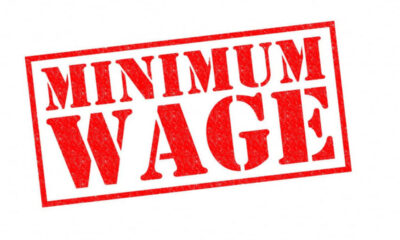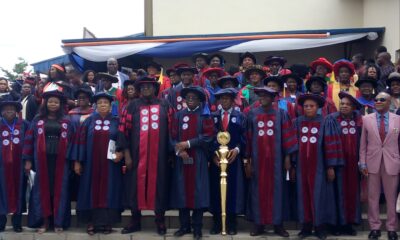Oil & Energy
Power Shortage: Lagos Artisans Count Losses
Some artisans working
in Lagos have urged the Federal Government to enhance their capacity for wealth creation by providing stable electricity supply across the country.
They told newsmen that the absence of electricity for commercial purposes negated government policy on small scale businesses and entrepreneurship.
Babatunde Olalekan, a barber, who disclosed that he earned about N1, 500 daily, said the absence of constant electricity had robbed him of his source of livelihood.
“Electricity supply and poor customer response to payment are my major challenges. “I really need light to operate because I can only use my clipper when there is electricity so that I can meet the needs of my customers. “I spend a lot in buying petrol to run my electricity generator which is expensive and discouraging,” he said.
Aderemilekun Yaya, a seamstress, said that poor electricity supply had made it near impossible for her to earn money and support her husband.
Yahaya, who has been in business for 10 years, also identified the ailing national infrastructure as another major setback to the development of SMEs.
“In a week I realise at least N5, 000 from the cloths I sew and I pay electric bills even when I am not using the light as I wish.
“I buy charcoal everyday for my coal iron so that I can iron my customers’ outfits when there is no power supply.
“The patronage I get is reducing, the reason being that my customers say that they find it hard to get to my shop to drop or receive their fabrics, all in the name of bad roads.
A tailor, Taofeek Adisa, said that poor electricity supply nationwide was compounded by dearth of support from the finance industry for SMEs.
“I want the government to assist me financially to boost my business. If I have financial support, I will continue with the business and not divert to something else,” Adisa said.
For Adijat Abatan, a photographer, financial challenge and poor electricity supply has made her nine years practice of photography fruitless.
She said the lack of the political will from both the government and the organised private sector to implement policies geared toward leveraging SMEs and poor power supply made entrepreneurship a difficult task in Nigeria.
Also speaking, Solomon Aderibigbe, a carpenter, said that poor electricity supply had compelled him to quit the trade for buying and selling of goods.
Aderibigbe also said that the nation’s challenged infrastructure, especially electricity had made it difficult for artisans to earn a living from their various trades and contribute to the economy.
Oil & Energy
FG Explains Sulphur Content Review In Diesel Production
The Federal Government has offered explanation with regard to recent changes to fuel sulphur content standards for diesel.
The Government said the change was part of a regional harmonisation effort, not a relaxation of regulations for local refineries.
The Chief Executive, Nigerian Midstream and Downstream Petroleum Regulatory Authority (NMDPRA), Farouk Ahmed, told newsmen that the move was only adhering to a 2020 decision by the Economic Community of West African States (ECOWAS) which mandated a gradual shift to cleaner fuels across the region.
Ahmed said the new limits comply with the decision by ECOWAS that mandated stricter fuel specifications, with enforcement starting in January 2021 for non-ECOWAS imports and January 2025 for ECOWAS refineries.
“We are merely implementing the ECOWAS decision adopted in 2020. So, a local refinery with a 650 ppm sulphur in its product is permissible and safe under the ECOWAS rule until January next year where a uniform standard would apply to both the locally refined and imported products outside West Africa”, Ahmed said.
He said importers were notified of the progressive reduction in allowable sulphur content, reaching 200 ppm this month from 300 ppm in February, well before the giant Dangote refinery began supplying diesel.
Recall that an S&P Global report, last week, noted a significant shift in the West African fuel market after Nigeria altered its maximum diesel sulphur content from 200 parts per million (ppm) to around 650 ppm, sparking concerns it might be lowering its standards to accommodate domestically produced diesel which exceeds the 200 ppm cap.
High sulphur content in fuels can damage engines and contribute to air pollution. Nevertheless, the ECOWAS rule currently allows locally produced fuel to have a higher sulphur content until January 2025.
At that point, a uniform standard of below 5 ppm will apply to both domestic refining and imports from outside West Africa.
Importers were previously permitted to bring in diesel with a sulphur content between 1,500 ppm and 3,000 ppm.
It would be noted that the shift to cleaner fuels aligns with global environmental efforts and ensures a level playing field for regional refiners.
Oil & Energy
PHED Implements April 2024 Supplementary Order To MYTO
The Port Harcourt Electricity Distribution (PHED) plc says it has commenced implementation of the April 2024 Supplementary Order to the MYTO in its franchise area while assuring customers of improved service delivery.
The Supplementary order, which took effect on April 3, 2024, emphasizes provisions of the MYTO applicable to customers on the Band A segment taking into consideration other favorable obligations by the service provider to Band A customers.
The Head, Corporate Communications of the company, Olubukola Ilvebare, revealed that under the new tariff regime, customers on Band A Feeders who typically receive a minimum supply of power for 20hours per day, would now be obliged to pay N225/kwh.
“According to the Order, this new tariff is modeled to cushion the effects of recent shifts in key economic indices such as inflation rates, foreign exchange rates, gas prices, as well as enable improved delivery of other responsibilities across the value chain which impact operational efficiencies and ability to reliably supply power to esteemed customers.
“PHED assures Band A customers of full compliance with the objectives of the new tariff order”, he stated.
Ilvebare also said the management team was committed to delivering of optimal and quality services in this cost reflective dispensation.
The PHED further informed its esteemed customers on the other service Bands of B, C D & E, that their tariff remains unchanged, adding that the recently implemented supplementary order was only APPLICABLE to customers on Band A Feeders.
Oil & Energy
Renewable Energy Boom With Waste Problem

As the global renewable energy capacity increases, so does the amount of waste from end-of-life equipment from solar, wind and other renewable energy activities. If we don’t address this problem soon, it could become a whole new threat to the environment and human health.
While a transition away from fossil fuels to alternative green energy sources is helping the world to reduce its greenhouse gas emissions and combat climate change, it is important to consider the implications that new energy activities may have on the environment.
Solar panels and wind turbines have a limited lifespan and need to be disposed of appropriately once they reach this point. While some components can be recycled and reused, much of the old equipment ends up in landfills due to the lack of infrastructure in place to manage the materials suitably.
Renewable energy equipment, such as solar panels, contains components that can be harmful to humans, such as lead and cadmium, as well as other materials, like glass, aluminum, and silicon, which can be harmful to the environment if disposed of improperly.
One way that out-of-use equipment can be managed is through the creation of standards, such as the Waste Electrical and Electronic Equipment (WEEE) directive from the European Union, which provides guidelines for the gathering, handling, recycling, and recovery of solar panels.
The U.S. Resource Conservation and Recovery Act (RCRA) also addresses the correct disposal of solar panels.
However, many countries have yet to introduce clear standards for renewable energy equipment disposal, which has led to dangerous methods of disposal.
Several countries around the globe are rapidly increasing their solar and wind energy capacity, which relies on the production and installation of millions of solar panels and turbines. Tens of millions of solar panels are being installed each year in the U.S. alone, and globally the figure is over a hundred million.
Despite the accelerated pace of the rollout, there are few recycling facilities prepared to manage old equipment.
Some countries are managing equipment disposal better than others. For example, France claims that 90 percent recycling efficiency is achieved in some of its flagship disposal facilities.
However, others do not have mechanisms in place to even consider recycling old equipment. While it is important to put proper waste disposal mechanisms in place for the safety of people and the environment, it can also be a lucrative business.
According to a study by the International Renewable Energy Agency (IRENA) and the U.S. Department of Energy’s National Renewable Energy Laboratory (NREL), the cumulative value of materials that can be recycled from solar photovoltaic (PV) waste is estimated at $4 billion by 2040 and $8.8. billion by 2050.
Supplies of many of the materials used to produce green energy equipment are finite, meaning it is important to recycle materials to reproduce equipment to continue to produce renewable energy. Jinlei Feng, a programme officer at IRENA, explained, “By 2050, there will be more than 210 million tonnes of cumulative solar PV waste globally and more than three-quarters of that waste will be generated after 2040 and 40% in the last five years between 2045-2050”.
Feng added, “Annual solar PV waste generation will touch 10 million tonnes by 2040 and increase to 20 million tonnes by 2050”.
India is currently trying to navigate solar waste problem. Pavagada in the south of India is home to the world’s third-largest solar power plant, which holds 25 million panels across a 50 km2 park, with a capacity of 2,050MW. There are 11 other giant solar parks across the country, with plans to develop a further 39 across 12 states by 2026.
However, with great solar ambitions comes significant waste. India is aiming for a solar output capacity of 280GW by 2030, of which 70.1GW is already installed.
One study predicts that this will produce an accumulation of over 600,000 tonnes of solar waste by the end of the decade, which could increase 32-fold to over 19 million tonnes by 2050.
Although there are protocols in place to manage the disposal of old equipment, which state that solar waste from the plants must be transferred to e-waste contractors, authorized by the Central Pollution Control Board (CPCB), within a specified timeframe – typically 90 or 180 days – few abide by these rules.
Most solar farms are in remote areas and must pay to transport old equipment to authorised contractors. Solar glass has no real value, meaning there is little incentive for waste contractors to collect and manage the equipment.
This has led to the development of a network of informal operators – who dismantle, aggregate, transport and recycle panels.
Instead of ensuring proper disposal methods are followed, many operators sell their waste equipment to informal buyers, meaning the materials cannot be recycled and repurposed, and many of the materials end up harming both people and the environment.
To ensure that renewable energy equipment is disposed of appropriately, and recycled where possible, governments must establish clear standards and regulations for energy waste disposal.
Further, they must ensure the mechanisms are in place and funding is available to guarantee proper disposal takes place. Without the necessary standards, green energy equipment could contribute to environmental and health problems in the coming decades.
Bradstock writes for Oilprice.com.
By: Felicity Bradstock
-

 Business4 days ago
Business4 days agoAXA Mansard Backs Female-Owned MSMEs With N1.4m Grant
-

 Editorial4 days ago
Editorial4 days agoTowards Minimum Wage Implementation
-

 Nation4 days ago
Nation4 days agoSDP National Chairman Lauds FG’s Efforts To Tackle Insecurity
-

 Breaking News4 days ago
Breaking News4 days agoTanker Inferno: We’re Saddened By Extent Of Carnage -Fubara
-

 Politics4 days ago
Politics4 days agoAPC Calls For Oyo LG Poll Cancellation
-

 Rivers4 days ago
Rivers4 days agoPolice Arrest Vigilante Commander, Others Over Robbery In Rivers
-

 Education4 days ago
Education4 days agoFormer VC Advocates Drug Test For University Lecturers
-

 News4 days ago
News4 days agoSpeak Truth To Power, Prof Omotola Tells Journalists

